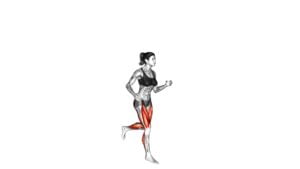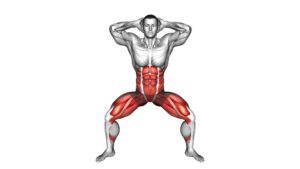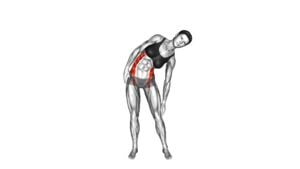Standing Half Bend (female) – Video Exercise Guide & Tips

Get ready to tone your body with the Standing Half Bend!
Watch This Exercise Video
This video exercise guide provides step-by-step instructions, tips, and modifications specifically designed for females.
Strengthen your core, improve flexibility, and enhance your posture with this effective exercise.
Whether you're a beginner or an advanced fitness enthusiast, this guide has got you covered.
Watch the video and start reaping the benefits of the Standing Half Bend today.
Key Takeaways
- The standing half bend improves flexibility in the hamstrings and lower back.
- It targets core muscles, including abdominals and obliques.
- Using a sturdy chair or yoga block provides support and helps maintain balance.
- It is important to avoid common mistakes such as rounding the back and using too much momentum.
Benefits of the Standing Half Bend
Discover the numerous benefits of the Standing Half Bend for improving flexibility and strengthening your core.
The Standing Half Bend is a versatile exercise that can be modified to suit your fitness level and goals.
One of the key benefits of this exercise is that it helps to improve flexibility in the hamstrings and lower back. By bending forward at the waist, you stretch and lengthen these muscles, which can help to alleviate tightness and improve range of motion.
Additionally, the Standing Half Bend targets your core muscles, including the abdominals and obliques. As you bend forward, these muscles engage to stabilize your body and maintain proper form. Strengthening your core is important for maintaining good posture and preventing lower back pain.
To ensure proper form for the Standing Half Bend, start by standing with your feet hip-width apart. Keep your back straight and engage your core. As you bend forward, hinge at the hips and keep your knees slightly bent. Avoid rounding your back and aim to bring your chest parallel to the floor.
Remember to breathe and hold the stretch for a few seconds before returning to the starting position.
Equipment Needed for the Exercise
To successfully perform the Standing Half Bend exercise, you'll need some essential equipment. This includes a yoga mat or a comfortable surface to stand on, as well as a set of dumbbells or resistance bands to add intensity to the workout.
If you don't have access to these items, don't worry! There are also alternatives that you can use, such as water bottles or household objects, to achieve similar results.
Essential Exercise Equipment
You will need one piece of essential exercise equipment for the standing half bend exercise. The good news is that this exercise doesn't require any fancy or expensive equipment.
All you need is a sturdy chair or a yoga block. These options are budget-friendly and easily accessible. The chair should be stable and able to support your weight. It will provide support and help you maintain balance while performing the standing half bend.
If you don't have a chair, a yoga block can be used as an alternative. Place it on the floor and use it as a prop to help you reach the desired position.
Alternatives to Expensive Gear
A sturdy chair or a yoga block can serve as affordable alternatives to expensive gear for the standing half bend exercise. If you're on a budget or prefer DIY alternatives, these options can provide the support you need.
A sturdy chair can be used to rest your hands or provide stability as you bend forward. Make sure the chair is stable and can withstand your weight.
Alternatively, a yoga block can be placed on the floor to provide support and help you maintain proper form. It's important to choose a block that's firm and stable.
These budget-friendly options allow you to perform the standing half bend exercise without investing in expensive equipment.
Step-By-Step Guide on How to Perform the Exercise
Proper execution of the exercise requires focus and control. To perform the Standing Half Bend (female) with proper form and technique, follow these step-by-step instructions:
- Stand with your feet hip-width apart and your knees slightly bent.
- Place your hands on your hips or let them hang by your sides.
- Slowly bend forward from your hips, keeping your back straight and your core engaged.
- Lower your upper body until it's parallel to the ground or until you feel a stretch in your hamstrings.
- Hold this position for a few seconds, then slowly return to the starting position by engaging your glutes and hamstrings.
- Repeat for the desired number of repetitions.
By following these steps, you can ensure that you're performing the Standing Half Bend (female) exercise correctly and effectively. Remember to maintain proper form throughout the exercise, focusing on engaging your core and keeping your back straight.
This exercise targets your hamstrings, glutes, and lower back, helping to improve your lower body strength and flexibility. Incorporate this exercise into your workout routine to enhance your overall fitness and achieve your goals.
Common Mistakes to Avoid While Doing the Standing Half Bend
To ensure proper form and maximize the effectiveness of the Standing Half Bend (female) exercise, it's important to be aware of common mistakes to avoid during its execution. By avoiding these mistakes, you can prevent potential injuries and achieve the desired results more efficiently.
One common mistake to avoid is rounding your back during the exercise. This can put unnecessary strain on your spine and lead to back pain. Instead, focus on keeping your back straight and maintaining a neutral spine throughout the movement.
Another mistake to watch out for is using too much momentum. It's important to engage your core and control the movement with your leg and glute muscles. Avoid swinging your body or relying on momentum to lift the weight. This will ensure that you're targeting the correct muscles and getting the most out of the exercise.
Lastly, be mindful of your knee alignment. Your knees should be in line with your toes throughout the exercise. Avoid letting your knees cave inwards or pushing them too far forward. This will help protect your knees and maintain proper form.
Tips for Maximizing the Effectiveness of the Exercise
To maximize the effectiveness of the exercise, you should focus on engaging your core and controlling the movement with your leg and glute muscles while avoiding excessive momentum. By following these tips, you can ensure that you're maximizing your results and performing the exercise with proper form:
- Maintain a stable core: Engage your abdominal muscles throughout the movement to stabilize your spine and prevent any unnecessary strain on your lower back.
- Control the movement: Slowly lower your upper body towards the floor while keeping your back straight. This will help you target the muscles in your legs and glutes more effectively.
- Avoid using momentum: Resist the temptation to use momentum to swing your body up and down. This won't only diminish the effectiveness of the exercise but also increase the risk of injury.
- Focus on the mind-muscle connection: Concentrate on the muscles you're targeting during the exercise. Visualize them working and contracting with each repetition to enhance the mind-muscle connection and maximize the results.
Modifications and Variations for Different Fitness Levels
Now let's talk about how to modify and vary the standing half bend exercise to suit different fitness levels.
If you're a beginner, there are modifications you can make to make the exercise more accessible and less challenging.
On the other hand, if you're more advanced, there are variations you can try to make the exercise more challenging and push your limits.
It's important to adapt the exercise to your own abilities and gradually progress as you become stronger and more comfortable with the movement.
Beginner-Friendly Modifications
How can you modify the standing half bend exercise to make it more beginner-friendly? Here are some beginner modifications and safety precautions to consider:
- Start with a wider stance: By positioning your feet slightly wider apart, you can create a more stable base and improve balance during the exercise.
- Bend your knees: Instead of fully straightening your legs, keep a slight bend in your knees to reduce strain on your lower back and make the movement more manageable.
- Use a support: If you're finding it challenging to maintain balance, you can place your hands on a stable object, such as a chair or wall, for added support.
- Decrease the range of motion: Rather than bending all the way down to touch your toes, focus on gradually increasing your flexibility by bending only as far as comfortable for you.
Challenging Advanced Variations
Are you ready to take your standing half bend exercise to the next level with challenging advanced variations?
If you're looking to push yourself and explore new possibilities, there are several challenging modifications and advanced techniques you can incorporate into your routine.
One option is to add weights to the exercise, holding dumbbells or kettlebells in your hands as you perform the movement. This will increase the intensity and engage your muscles even more.
Another advanced variation is to perform the exercise on an unstable surface, such as a Bosu ball or a balance board. This will challenge your balance and stability, forcing your muscles to work harder to maintain control.
Lastly, you can try incorporating dynamic movements into the exercise, such as a jump or a lunge, to further challenge your strength and coordination.
Remember to always listen to your body and gradually progress to more challenging variations.
Adapting for Different Abilities
To adapt the standing half bend exercise for different fitness levels, you can modify the intensity, incorporate variations, and adjust the range of motion to suit your abilities. Here are some different adaptations and inclusive modifications you can try:
- Decrease the intensity by bending your knees slightly instead of fully straightening them, allowing for less strain on your leg muscles.
- Incorporate variations by using a chair or wall for support, which can help with balance and stability.
- Adjust the range of motion by only bending halfway instead of all the way down, providing a less challenging movement for those with limited flexibility.
- Include modifications by using lighter weights or no weights at all, making the exercise more manageable for beginners or individuals with lower strength levels.
Remember to listen to your body and make adjustments as needed to ensure a safe and effective workout.
Frequently Asked Questions
How Many Calories Does the Standing Half Bend Exercise Burn?
The standing half bend exercise can be a great addition to your daily workout routine. It not only helps strengthen your lower back and core muscles but also improves flexibility and posture.
As for the number of calories burned, it can vary depending on factors like intensity and duration. However, keep in mind that weight loss isn't solely determined by calorie burn during exercise.
It's important to maintain a balanced diet and overall active lifestyle for optimal results.
Can the Standing Half Bend Exercise Help Improve Posture?
The standing half bend exercise can be a great way to improve your posture. By engaging the muscles in your back, core, and legs, this exercise helps to strengthen and stabilize your spine, leading to better alignment and posture.
Additionally, there are various modifications you can make to suit your fitness level and target specific areas. The benefits of the standing half bend include increased flexibility, improved balance, and reduced risk of back pain.
Is the Standing Half Bend Exercise Suitable for Individuals With Lower Back Pain?
The standing half bend exercise can be modified to accommodate individuals with lower back pain. To alleviate discomfort, try using a support like a chair or wall for balance.
Alternatively, there are other exercises that can help strengthen the core and improve posture without putting strain on the lower back.
It's important to consult with a healthcare professional or a qualified fitness trainer to find the best alternatives for your specific needs.
What Muscles Does the Standing Half Bend Exercise Primarily Target?
The standing half bend exercise primarily targets your core muscles, including the obliques and lower back. It also engages the glutes, hamstrings, and quadriceps.
By performing this exercise, you can strengthen your core and improve your posture.
To get the most out of the standing half bend, remember to maintain proper form. Keep your back straight, engage your core, and hinge at your hips while bending sideways.
This will ensure you maximize the standing half bend benefits.
How Often Should the Standing Half Bend Exercise Be Performed for Optimal Results?
To get the best results from the Standing Half Bend exercise, it's important to perform it regularly.
Without the context of the Standing Half Bend (female) – Video Exercise Guide & Tips {590312}, I can't give you specific recommendations.
However, in general, aim to incorporate this exercise into your routine at least 2-3 times per week. Consistency is key!
Remember to consult with a fitness professional or refer to the mentioned guide for more detailed instructions and personalized recommendations.
Conclusion
In conclusion, the standing half bend is a beneficial exercise that can help improve flexibility and strengthen the lower body.
It requires minimal equipment and can be easily modified for different fitness levels.
By following the step-by-step guide and avoiding common mistakes, you can maximize the effectiveness of this exercise.
Incorporate the standing half bend into your fitness routine to achieve better overall health and fitness.

Author
Years ago, the spark of my life’s passion ignited in my mind the moment I stepped into the local gym for the first time. The inaugural bead of perspiration, the initial endeavor, the very first surge of endorphins, and a sense of pride that washed over me post-workout marked the beginning of my deep-seated interest in strength sports, fitness, and sports nutrition. This very curiosity blossomed rapidly into a profound fascination, propelling me to earn a Master’s degree in Physical Education from the Academy of Physical Education in Krakow, followed by a Sports Manager diploma from the Jagiellonian University. My journey of growth led me to gain more specialized qualifications, such as being a certified personal trainer with a focus on sports dietetics, a lifeguard, and an instructor for wellness and corrective gymnastics. Theoretical knowledge paired seamlessly with practical experience, reinforcing my belief that the transformation of individuals under my guidance was also a reflection of my personal growth. This belief holds true even today. Each day, I strive to push the boundaries and explore new realms. These realms gently elevate me to greater heights. The unique combination of passion for my field and the continuous quest for growth fuels my drive to break new ground.







